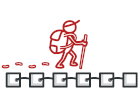
Iterator in Go
Iterator is a behavioral design pattern that allows sequential traversal through a complex data structure without exposing its internal details.
Thanks to the Iterator, clients can go over elements of different collections in a similar fashion using a single iterator interface.
Conceptual Example
The main idea behind the Iterator pattern is to extract the iteration logic of a collection into a different object called iterator. This iterator provides a generic method of iterating over a collection independent of its type.
collection.go: Collection
package main type Collection interface { createIterator() Iterator } userCollection.go: Concrete collection
package main type UserCollection struct { users []*User } func (u *UserCollection) createIterator() Iterator { return &UserIterator{ users: u.users, } } iterator.go: Iterator
package main type Iterator interface { hasNext() bool getNext() *User } userIterator.go: Concrete iterator
package main type UserIterator struct { index int users []*User } func (u *UserIterator) hasNext() bool { if u.index < len(u.users) { return true } return false } func (u *UserIterator) getNext() *User { if u.hasNext() { user := u.users[u.index] u.index++ return user } return nil } user.go: Client code
package main type User struct { name string age int } main.go: Client code
package main import "fmt" func main() { user1 := &User{ name: "a", age: 30, } user2 := &User{ name: "b", age: 20, } userCollection := &UserCollection{ users: []*User{user1, user2}, } iterator := userCollection.createIterator() for iterator.hasNext() { user := iterator.getNext() fmt.Printf("User is %+v\n", user) } } output.txt: Execution result
User is &{name:a age:30} User is &{name:b age:20} Based on: Golang By Example
 WINTER SALE IS ON!
WINTER SALE IS ON! 